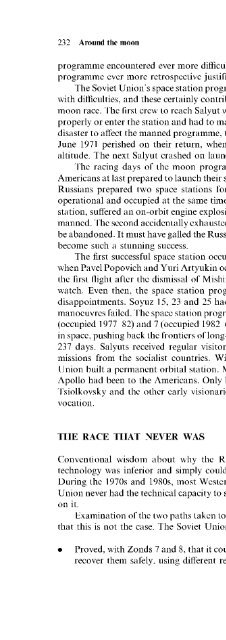Soviet and Russian Lunar Exploration
Soviet and Russian Lunar Exploration
Soviet and Russian Lunar Exploration
You also want an ePaper? Increase the reach of your titles
YUMPU automatically turns print PDFs into web optimized ePapers that Google loves.
programme encountered ever more difficulties, the <strong>Russian</strong>s gave their space station<br />
programme ever more retrospective justification.<br />
The <strong>Soviet</strong> Union's space station programme in the early to mid-1970s was cursed<br />
with difficulties, <strong>and</strong> these certainly contributed to Mishin's downfall as much as the<br />
moon race. The first crew to reach Salyut was able to link to the station, but not dock<br />
properly or enter the station <strong>and</strong> had to make an emergency return. In the worst-ever<br />
disaster to affect the manned programme, the three cosmonauts who flew to Salyut in<br />
June 1971 perished on their return, when a depressurization valve opened at high<br />
altitude. The next Salyut crashed on launch in July 1972.<br />
The racing days of the moon programme echoed again in spring 1973 as the<br />
Americans at last prepared to launch their space station, Skylab. To match Skylab, the<br />
<strong>Russian</strong>s prepared two space stations for launch, planning to have both of them<br />
operational <strong>and</strong> occupied at the same time. The first, which was also the first Almaz<br />
station, suffered an on-orbit engine explosion <strong>and</strong> had to be ab<strong>and</strong>oned before it was<br />
manned. The second accidentally exhausted all its fuel on its first orbit <strong>and</strong> also had to<br />
be ab<strong>and</strong>oned. It must have galled the <strong>Russian</strong>s that America's Skylab then went on to<br />
become such a stunning success.<br />
The first successful space station occupation did not take place until July 1974,<br />
when Pavel Popovich <strong>and</strong> Yuri Artyukin occupied the second Almaz station. This was<br />
the first flight after the dismissal of Mishin <strong>and</strong> the first to take place on Glushko's<br />
watch. Even then, the space station programme was to suffer many setbacks <strong>and</strong><br />
disappointments. Soyuz 15, 23 <strong>and</strong> 25 had to come down early when their docking<br />
manoeuvres failed. The space station programme did not reach maturity until Salyut 6<br />
(occupied 1977-82) <strong>and</strong> 7 (occupied 1982-6). Here, <strong>Soviet</strong> cosmonauts learned to live<br />
in space, pushing back the frontiers of long-distance flight to 96,139,175,185,211 <strong>and</strong><br />
237 days. Salyuts received regular visitors: unmanned refuelling craft <strong>and</strong> visiting<br />
missions from the socialist countries. With Mir (occupied 1986-2000), the <strong>Soviet</strong><br />
Union built a permanent orbital station. Mir became to the <strong>Soviet</strong> programme what<br />
Apollo had been to the Americans. Only by returning to its roots in the writings of<br />
Tsiolkovsky <strong>and</strong> the other early visionaries did the programme at last find its true<br />
vocation.<br />
THE RACE THAT NEVER WAS<br />
Conventional wisdom about why the <strong>Russian</strong>s lost the moon race is that their<br />
technology was inferior <strong>and</strong> simply could not match the sophistication of Apollo.<br />
During the 1970s <strong>and</strong> 1980s, most Western observers took the view that the <strong>Soviet</strong><br />
Union never had the technical capacity to send cosmonauts to the moon or l<strong>and</strong> them<br />
on it.<br />
Examination of the two paths taken to the moon by the space superpowers shows<br />
that this is not the case. The <strong>Soviet</strong> Union:<br />
• Proved, with Zonds 7 <strong>and</strong> 8, that it could send cosmonauts around the moon <strong>and</strong><br />
recover them safely, using different return trajectories.







